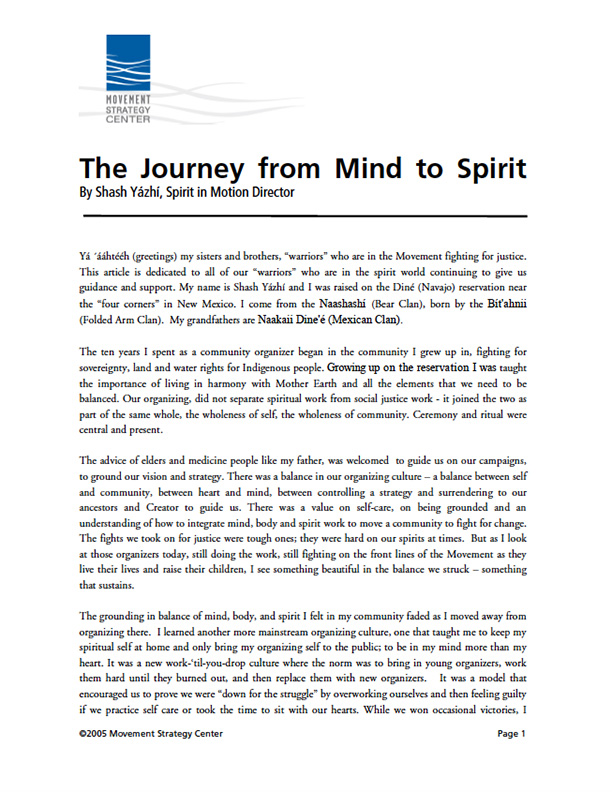The Journey from Mind to Spirit
Shash Yázhí, an activist raised on the Diné (Navajo) reservation near the “four corners” in New Mexico, discusses the difficult and exhaustive organizing challenges of this moment in time and the importance of creating a sustainable movement for future warriors.
By Shash Yazhi
Published 2005
Yá ááhtééh (greetings) my sisters and brothers, “warriors” who are in the Movement fighting for justice. This article is dedicated to all of our “warriors” who are in the spirit world continuing to give us guidance and support.
My name is Shash Yázhí and I was raised on the Diné (Navajo) reservation near the “four corners” in New Mexico. I come from the Naashashí (Bear Clan), born by the Bít’ahnii (Folded Arm Clan). My grandfathers are Naakaii Dine’é (Mexican Clan). The ten years I spent as a community organizer began in the community I grew up in, fighting for sovereignty, land and water rights for Indigenous people.
Growing up on the reservation I was taught the importance of living in harmony with Mother Earth and all the elements that we need to be balanced. Our organizing, did not separate spiritual work from social justice work — it joined the two as part of the same whole, the wholeness of self, the wholeness of community. Ceremony and ritual were central and present. The advice of elders and medicine people like my father, was welcomed to guide us on our campaigns, to ground our vision and strategy.
There was a balance in our organizing culture — a balance between self and community, between heart and mind, between controlling a strategy and surrendering to our ancestors and Creator to guide us. There was a value on self-care, on being grounded and an understanding of how to integrate mind, body and spirit work to move a community to fight for change. The fights we took on for justice were tough ones; they were hard on our spirits at times.
But as I look at those organizers today, still doing the work, still fighting on the front lines of the Movement as they live their lives and raise their children, I see something beautiful in the balance we struck — something that sustains. The grounding in balance of mind, body, and spirit I felt in my community faded as I moved away from organizing there. I learned another more mainstream organizing culture, one that taught me to keep my spiritual self at home and only bring my organizing self to the public; to be in my mind more than my heart. It was a new work-‘til-you-drop culture where the norm was to bring in young organizers, work them hard until they burned out, and then replace them with new organizers. It was a model that encouraged us to prove we were “down for the struggle” by overworking ourselves and then feeling guilty if we practice self care or took the time to sit with our hearts.
While we won occasional victories, I observed something else about this type of organizing culture: There was no grounding in personal spiritual regeneration to sustain us through our work years, so that we could see our vision through to manifestation — five, ten, 30, and 50 years from now. I kept practicing the traditional medicine way that my father had taught me, but kept it separate from my work. Where was the balance for sustaining the longevity of the larger movement? I saw my peers questioning whether they could continue to do this work. Most of them, like me, had come into organizing from their hearts, from a fire in their bellies to fight injustice, but they were struggling within organizational cultures that disconnected them from their passions. One by one I watched dedicated warriors go through the burnout cycle and leave the movement. Many left in search of healthier ways of living.
As a Movement we must begin to take the time to ask the questions: Why are organizers leaving the Movement and where are they going? Why have they lost the passion for organizing? What needs to be done at the individual, organizational and community levels to address the burnout rate? Do we need to change the culture of organizing?
Increasingly, there is a simple awareness: we must take care of ourselves in order to truly give to our communities. So, now is the time for the Movement to respond to the long-standing need for sustainability and ask: What does a healthy organization look like? This question grew louder for me as I myself began to feel the physical and emotional wear and tear of this organizing culture. I finally made the difficult decision to let go of an organizing job that was familiar, to begin building a bridge between mind and spirit throughout the Movement. I wanted to create sustainability for myself, for others, and for the Movement as a whole.
The toughest part of this transition was opening myself, again, to checking in with my heart and spirit after I had spent so much time as an organizer running from both. I called on my ancestors and spirit guides for the memory of a different way of walking in the Movement and for the courage to surrender. I was coming full circle; I was on a journey home but it was not easy.
Chief Joseph (Nez Perce) once said “The longest journey you will ever make in life is from your mind to your heart.” This is when I began to give breath to my life journey and was guided to the Movement Strategy Center, an organization that’s working to grow the Movement through alliance and network building, where I found other brothers and sisters who shared my commitment to support organizers in taking their own health and healing seriously for their own sake and the sake of their families, communities and the struggle. Spirit in Motion (SIM) was created. We began working with organizers and other individuals in the social justice movement who wish to create internal healing and balance in their lives and their work.
SIM is a program supporting the integration of one’s spirit and health on an individual, organizational and community plane to create a stronger, more sustainable movement for social justice. SIM is weaving the spirit of love, hope and strength of our ancestors through our daily struggle for justice. The program is structured around the four seasons (Spring, Summer, Fall, and Winter) to reconnect us to this natural cycle. Using the seasons, directions and time of day allows energy to flow well and honors this time of creation and balance. We have worked with organizations making the commitment to create healthier practices within their organizing efforts. These efforts seek to replace the old workaholic culture that compartmentalizes our lives by creating a new pattern and a new language in the organizing culture — one that values reflection, healing, balance, self-care, heart, grounding, hope, and holistic practice. Over the past year we have worked with over 150 individuals who have made the commitment to balance their lives with spirit, family, relationships, and work.
Only when we honor our own need to heal we are able to support the healing of our communities. This healing and love must become the foundation of our collective movement for social change. During this time I have had many sisters and brothers come up to me with tears in their eyes saying I need support, I need a place where I can heal, I need to know that it is okay to allow my tears to flow and feel my pain. Rona Fernandez, Californians for Justice activist shared “The spiritual support from Spirit in Motion has been deeply healing and has brought me to a place of groundedness and clarity that I would never have been able to achieve alone. This is so needed right now as movement activists struggle with building a better world amidst so much suffering and division.” We must recognized that as organizers we are also affected by the suffering and oppression of our communities. As we face the difficult organizing challenges of this moment in time, it is important for us to pull together to create a sustainable movement for future warriors. It is the season for a new kind of organizing to bloom.
For more information on Spirit in Motion, email Shash Yázhí at [email protected].
Original publication is available here.


